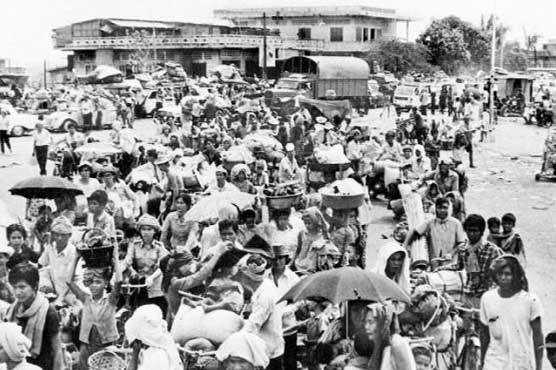Cambodia marks 40 years since evacuation of Phnom Penh

The sick, elderly and very young perished
PHNOM PENH (AFP) - Tearful survivors on Friday marked 40 years to the day since the black-clad Khmer Rouge marched into Phnom Penh, ending a civil war but heralding a terror that killed a quarter of Cambodians and turned the capital into a ghost town.
A few hundred people, including monks and elderly regime survivors, gathered early Friday at Choeung Ek -- the most notorious of the regime s "Killing Fields" on the capital s outskirts -- burning incense and saying Buddhist prayers at a memorial stupa housing the skulls and bones of victims.
The event commemorates the April 17, 1975 triumph of the hardline communist Khmer Rouge over the US-backed republican army of Lon Nol.
Initially, as the soldiers entered Phnom Penh astride tanks, their distinctive red-chequered scarves fluttering behind them, they were given a cautious welcome by the city s war-weary residents.
That warmth swiftly turned to horror as the cadres evacuated the city of two million people at gunpoint, in one of the largest forced migrations in recent history.
The sick, elderly and very young perished, their bodies littering the roadsides, as the "bourgeois" city dwellers were marched into the countryside to scratch a living from the parched, over-used soil.
By the time the tyrannical rule of Pol Pot -- or "Brother Number One" -- was ousted four years later, an estimated two million Cambodians had been killed by execution, starvation or overwork as the Khmer Rouge drove the country back to "Year Zero" in a madcap agrarian peasant revolution.
Among them were 36 of Huot Huorn s relatives. Of her family she survived alongside three of her sisters.
"Forty years ago Pol Pot turned Cambodia into a hell -- a ghost land," she told AFP with tears in her eyes after lighting incense for her loved ones.
"I still hate that regime... their sins are vivid in my eyes now. They starved us, jailed people with no food and water until they died... I saw them smash childrens heads against a tree trunk."
-- Horror untold --
===================
Only after the regime was forced out by Vietnamese soldiers in 1979 did the scale of the its atrocities emerge, with the bones of thousands of victims uncovered at several mass graves, including at Choeung Ek.
The scrub of land was the resting place of thousands of people perceived to be enemies of the revolution.
Many had first suffered at Phnom Penh s notorious torture house -- Tuol Sleng, or S21.
The former school-turned-torture-chamber has also been preserved as a grisly testament to the horrors of the era, which ended when the Khmer Rouge were forced to retreat to jungle hideouts.
In 2010, a UN-backed war crimes court sentenced former Tuol Sleng prison chief Kaing Guek Eav, alias Duch, to 30 years in prison -- later increased on appeal to life -- for overseeing the deaths of 15,000 people.
He was the first person to be held accountable for the regime s crimes.
Last August the two most senior surviving Khmer Rouge leaders -- Nuon Chea, 88, known as "Brother Number Two", and former head of state Khieu Samphan, 83 -- were given life sentences for crimes against humanity. Both have appealed.
Their two-year trial focused on the forced evacuation of Cambodians from Phnom Penh into rural labour camps as well as murders at one execution site.
In March, the court charged three more former Khmer Rouge members with crimes against humanity, ignoring warnings by strongman Cambodian premier Hun Sen -- a mid-ranking regime cadre before he defected -- that further prosecutions risked reigniting conflict.

